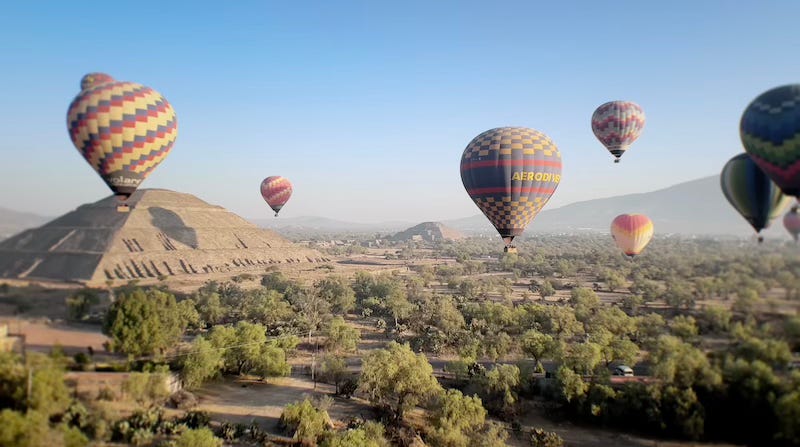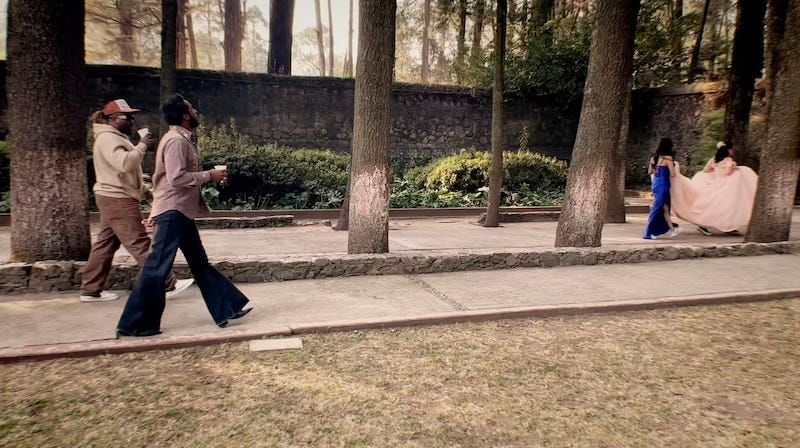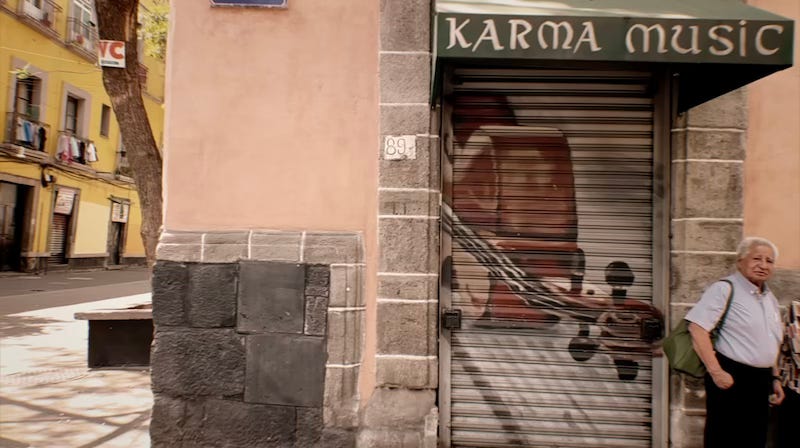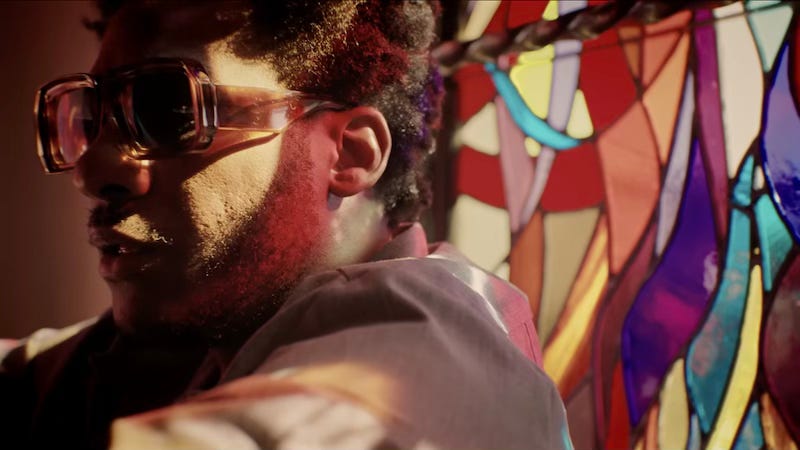Down in Mexico City With Leon Bridges
Dissecting scenes from the artist's music video for "Peaceful Place."
Mark your calendar for Oct. 4: Leon Bridges is dropping his fourth studio album, Leon.
Born in Atlanta and raised in Fort Worth, Texas, Bridges got his first big look in the mid-2010s after uploading “Coming Home” to SoundCloud. The 3 minutes, 36 seconds-long song immediately conjured up comparisons to both Otis Redding and Sam Cooke for its soulful, throwback spirit. Over the years, the 35-year-old singer-songwriter has explored a number of musical styles without abandoning neither his soul and rhythm & blues formation, nor Southern sensibilities.
Leon, as Bridges has shared via social media, promises to continue this trend. Figuring out everything he wanted to share on his fourth project, however, took time and a change of scenery.
Enter: Mexico City.
According to Bridges, his upcoming album took three years to write. Somewhere along the way, he began to feel the urge to refine his vision for Leon, landing on the idea to visit Mexico to, as he put it, “figure out the statement.” Bridges shared glimpses of his recording process through Instagram from March 11 to June 4. In these clips, the Texan was pictured in unnamed locations in and outside of Mexico City. Those familiar with Bridges’ whereabouts excitedly commented on these clips, not only applauding the artist for showing love to his neighbors across the border, but also asking about tour dates in Mexico.
On Aug. 2, Bridges confirmed that the first single off Leon was titled “Peaceful Place.” Almost a week later, he dropped the song’s official music video on YouTube. Across 3 minutes, 56 seconds, director Joshua Moore and crew capture some of the places that helped Bridges “find that spirit in [his] soul” that allowed him to tell his story in the music.
The GRAMMY-award winner could’ve surely recorded an excellent album anywhere in the world – he’s done it before – but he chose Mexico City. As someone who’s spent a good amount of time in Mexico’s capital over the last few years, I was ecstatic to see one of my favorite artists draw inspiration from the city I’ve fallen in love with. Watching the music video for “Peaceful Place” tripped me out because it featured locations off the beaten path that I know well.
And now you can too.
The “Peaceful Place” music video opens with an aerial shot of Mexico City. At quick glance, the shot is nondescript, but close inspection of the bottom-left corner reveals two large structures: Plaza México and Estadio Ciudad de los Deportes.
Both buildings were inaugurated in 1946 as parts of a larger “city of sports” that’s currently located in Mexico City’s Benito Juarez borough. While far from state-of-the-art facilities, both Plaza México and its neighbor to the right are iconic landmarks. The former is the world’s largest bullring, with a capacity of over 40,000 seats; it’s also hosted a number of crowd-drawing boxing matches throughout the years. Estadio Ciudad de los Deportes only seats 33,000 spectators, but is home to three of Mexico’s most important soccer teams: Atlante F.C., Cruz Azul, and Club América.
The surrounding area is mostly residential, but a good number of office buildings and commercial businesses line Av. Insurgentes Sur. The nearby Parque Hundido (Sunken Park) is a nice place to people-watch.
From south-east of the Historic Center, the music video takes us north to Tlatelolco.
By the looks of the first sign of this area of the city, it’s probable this shot was captured on a Sunday between the hours of 8 a.m. and 2 p.m. Over 13 miles of city streets – including the ever-important Av. Paseo de la Reforma – are closed off for 90,000 cyclists and runners to enjoy.
On the left side of the take, you can see a dark-colored statue atop a graffiti-tagged base. This is the Monumento a Cuitláhuac, a bronze sculpture inaugurated in 1964 that depicts the penultimate Aztec emperor in a defiant stance.
In the distance, you can see several buildings from the Conjunto Urbano Nonoalco-Tlatelolco, the largest apartment complex in Mexico (and second-largest in North America, behind only the Bronx’s Co-op City). Developed throughout the early 1960s, Nonoalco-Tlatelolco was a “city-within-a-city,” promising an insulated, modern life for people of all socioeconomic backgrounds.
In Cuitláhuac’s time, the area was known for its large open-air market.
Mario Pani’s design is perhaps best known for an event that transpired on Oct. 2, 1968: La Masacre de Tlatelolco. Like in other parts of the world, student activism was strong in Mexico throughout the ‘60s. Around 10,000 college-goers and high schoolers from across the country gathered in the Plaza de las Tres Culturas as an act of defiance against the government. The concerned activists were peaceful on the plaza – which features a mix of Meso-American, Spanish colonial, and modern architecture – but the Mexican Armed Forces opened fire on the unnamed civilians due to orders from the President. Dozens of students were killed and hundreds were left injured. It wasn’t until the year 2000 that those responsible were officially held responsible.
Today, the apartment complex is no longer considered “modern living.” It was widely neglected following the events of ‘68 and has been heavily impacted by earthquakes throughout the years.
On Sundays, you’ll find an antique market minutes away from Tlatelolco.
Located in the city’s Lagunilla neighborhood, the open-air bazaar has been a mainstay since 1957. Vendors from across the Mexico City-metropolitan area set up shop on the streets and lots found just north of the National Palace. You can find rare art, as well as vintage clothing, wares, and other items at an array of prices. Feeling parched or hungry? Micheladas, tacos, and tortas in the tianguis’ food section got you covered.
The market is relatively safe, but beware that Lagunilla exists in one of the city’s more notorious sections. If you’ll be drinking, do so responsibly and with attention to your belongings. Cash is king here.
After shopping for vintage wares, you can venture an hour north to Teotihuacan, the ancient Meso-American city.
While technically outside of Mexico’s capital, Teotihuacan is close enough to Mexico City’s center to commonly be included in any visit’s itinerary. Its draw is without a doubt the pre-Columbian and pre-Aztec pyramids and ruins, which can be enjoyed from above while in a hot-air balloon.
Since COVID, it seems you aren’t able to walk up either the Pyramid of the Sun or the Pyramid of the Moon, but you can walk through the Palacio de Quetzalpapálotl to get a more intimate feel of what life was like in the year 475.
The Museum of Anthropology is a great place to see some of the remains found at Teotihuacan, and learn about some of Mexico’s other Meso-American settlements and people.
Check out La Gruta if you ever find yourself in Teotihuacan and want to grab a bite in a pretty surreal setting.
Much of the “Peaceful Place” music video is shot at and around the Desierto de los Leones, a national park at the southwest outskirts of Mexico City.
If you ever find yourself in the Mexican capital and Chapultepec Park doesn’t satiate your desire for a tranquil green space, consider the 13-mile trip to the Desierto de los Leones. The air is crisper, the wind cooler, and the overall layout will have you asking if you’re really still in Mexico City.
Contrary to what the location’s name might suggest, the Desert of the Lions isn’t arid and dry nor the site of big cats. Instead, “Desierto de los Leones” nods to the area’s past as a sparsely-populated woodland managed by the Leon family in the 17th century on behalf of the Order of the Discalced Brothers of the Blessed Virgin Mary of Mount Carmel.
From 1606 to 1814, the national park was the site of the Barefoot Carmelites’ convent as the location offered serenity in direct contrast to New Spain’s restlessness. Once the Mexican War of Independence began, however, the convent was turned into a military headquarters by the city’s government. President Lazaro Cardenas named the monastery a national monument in 1937, including it in the preservation of the surrounding park.
The Desierto de los Leones is a perfect getaway from Mexico City, with hiking trails, waterfalls, and picnic areas.
Bridges recorded Leon near the Desierto de los Leones at El Desierto Casa-Estudio, a residential recording studio nestled away from the business of Mexico City.
El Desierto Casa-Estudio has hosted the likes of Bunbury, Natalia Lafourcade, and Siddhartha.
Back in the rustle-and-bustle of the city, you’ll find a replica of Michelangelo’s David sculpture in Plaza Río de Janeiro.
Located in the Roma neighborhood, the replica is made from bronze and was placed at its current location in 1976. The park itself is a great place to people-watch or walk your pets, and the surrounding area also delivers on art-deco architecture that’ll transport you to the past.
Food options are abundant in Colonia Roma, with Panaderia Rosetta and Jenni’s Quesadillas being two standout spots. If you’re looking for live jazz and good drinks on a weekend night, check out Casa Franca (reservations recommended). Licorería Limantour, the 7th Best Bar in the world according to @50bestbars (2023) is nearby, too.
If you can imagine it, you can likely find it in Mexico City’s Historic Center.
Stretches of Simón Bolívar perfectly embody this sentiment as they serve as the music and instrument-related sections of the city. Other parts of some of the Centro Historico’s streets are dedicated to everything from wedding dresses to art supplies, offering visitors wholesale prices on all kinds of goods. These streets tend to be busiest on Saturdays and Sundays.
Simón Bolívar 89 is right in front of Plaza de Regina, an open space that connects to the aptly-named Calle Regina. The Parroquia de la Natividad de María Santísima is situated in the plaza, welcoming the faithful and curious alike at all times of the day. This area is truly off the beaten path and delivers an authentic slice of life in Mexico City.
Café Jekemir is a great pitstop on the way east. If you’re looking for more than coffee, Coox Hanal has all the cochinita pibil and other Yucatan food you can ask for. Tortas y Hamburguesas at Regina 42 has some – you guessed it – decent torta sandwiches and hamburgers. You can have drinks at some of the bars next door after. Pulquería La Risa up the Callejon Mesones will take you back 100 years to a time that pulque, the fermented Meso-American drink, ruled Mexico City. Its upkeep has not been great in recent times, but it’s always recommended to take a peek through the swinging doors.
Mexico City’s metro station moves countless people on the daily. Most passengers move with purpose and in a rush, but if you’re ever near a metro station, you might find it worthwhile to treat it like a gallery space for moving art.
There’s no telling where Bridges and team filmed these shots with stained glass in the background, but Metro Candelaria in Mexico City provides a similar aesthetic.











